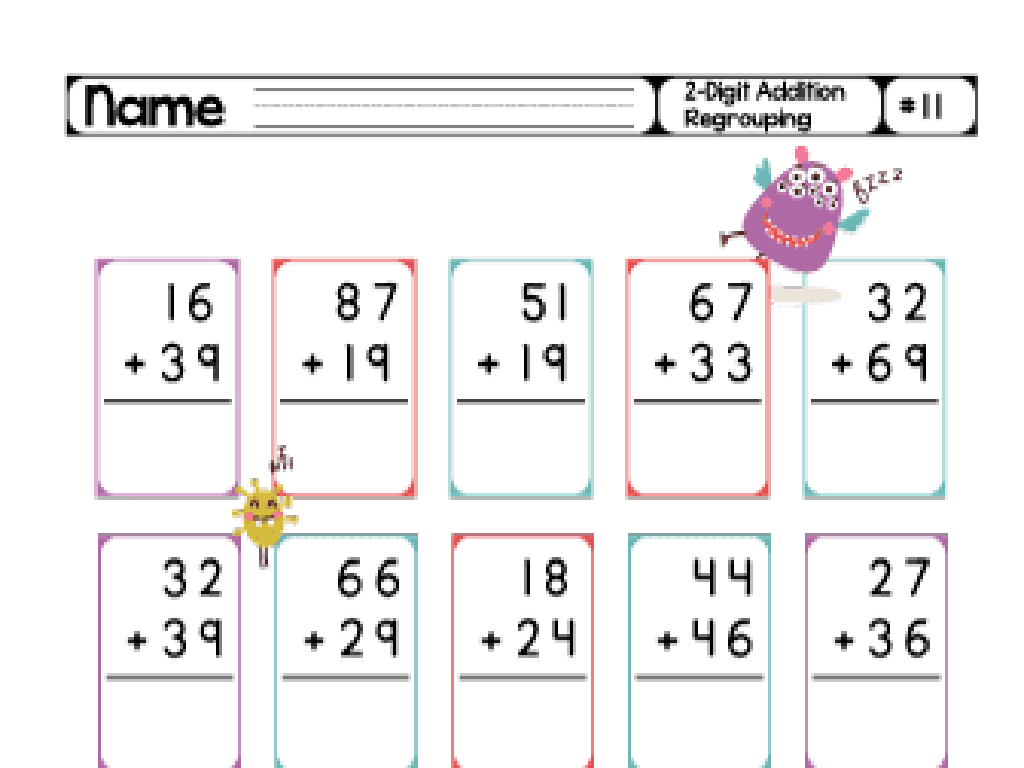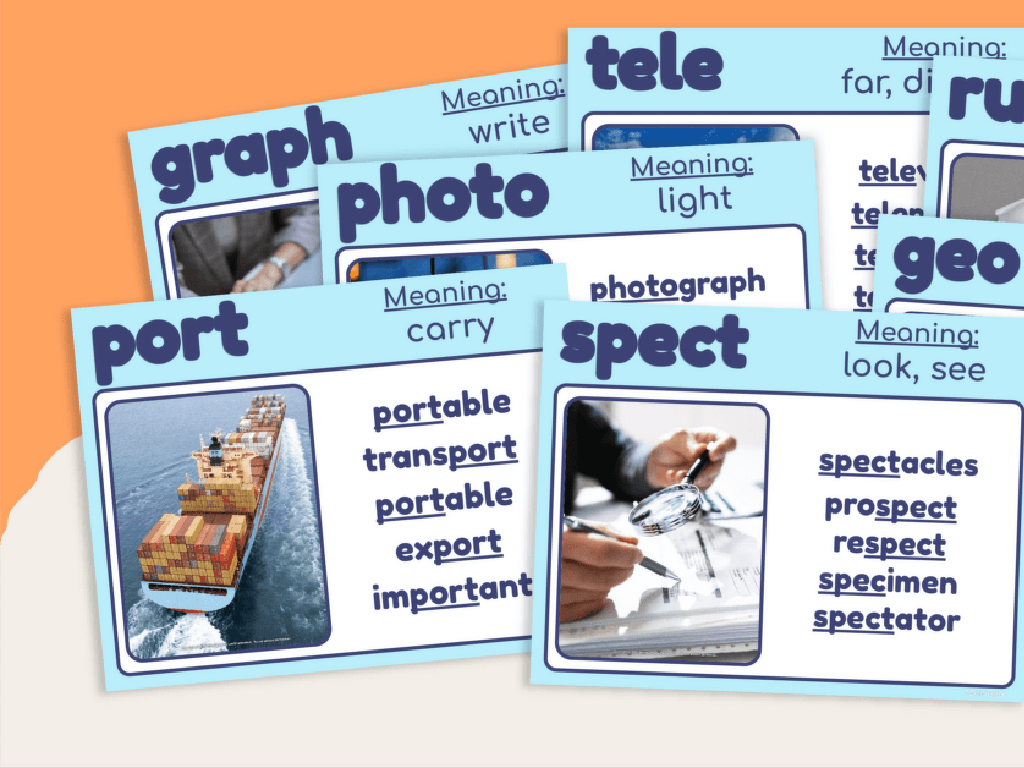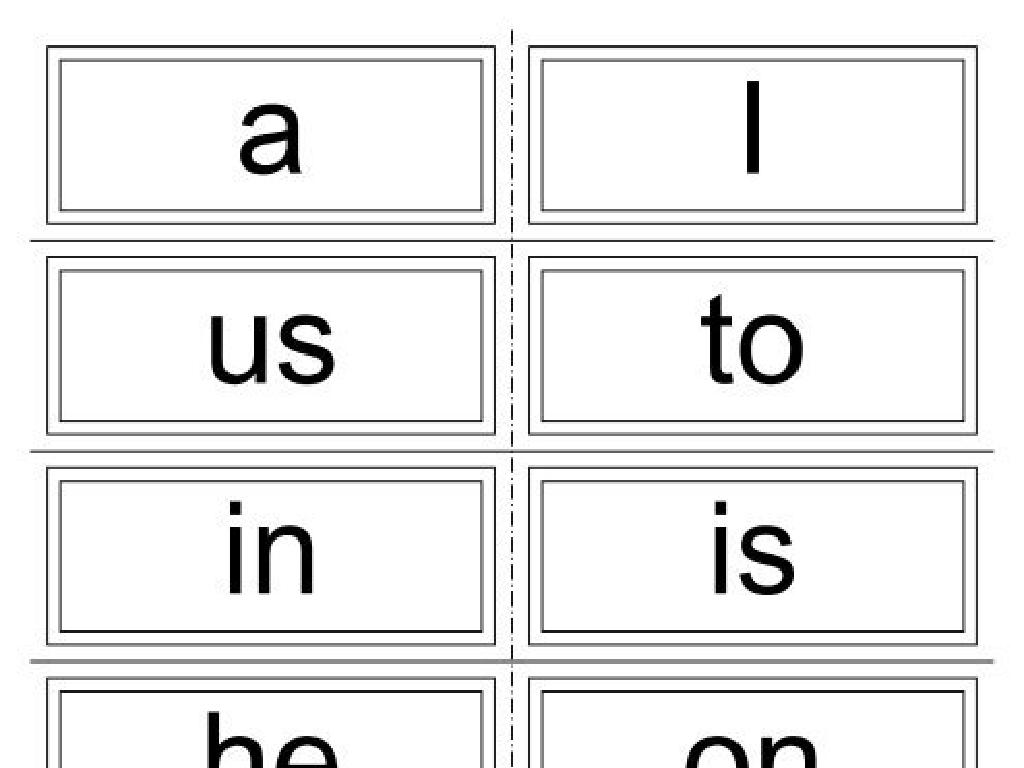Solve Percent Word Problems
Subject: Math
Grade: Sixth grade
Topic: Percents Of Numbers
Please LOG IN to download the presentation. Access is available to registered users only.
View More Content
Welcome to Percents!
– Understanding Percents
– Percents represent parts of a hundred, like 25% is 25 out of 100
– Percents, Fractions, and Decimals
– Every percent has a fraction and decimal equivalent, e.g., 50% = 1/2 = 0.5
– Real-life Percent Applications
– Percents are used in discounts, interest rates, and statistics
– Practice with Word Problems
|
This slide introduces students to the concept of percents and their importance in both math and everyday life. Begin by explaining that ‘percent’ means ‘per hundred’ and is a way to express fractions and decimals in a standardized form. Show how to convert between percents, fractions, and decimals with a few examples. Discuss how percents are used in various real-life scenarios such as calculating sales tax, determining discounts during shopping, and understanding interest rates on savings. Conclude by emphasizing the practicality of percents and encourage students to think of other areas where percents are applicable. Prepare to engage students with word problems that apply these concepts in the next class.
Understanding Percents
– Percent means ‘per hundred’
– The percent symbol: %
– Convert fractions to percents
– To convert, multiply the fraction by 100 and add a % sign
– Convert decimals to percents
– Multiply the decimal by 100 and add a % sign
|
This slide introduces the concept of percent to the students. Begin by explaining that the word ‘percent’ comes from the Latin ‘per centum’, which means ‘per hundred’. This is why percents are essentially fractions with a denominator of 100. Show the percent symbol and explain its use in denoting percentages. Then, demonstrate how to convert fractions and decimals to percents by multiplying by 100. For example, to convert 1/4 to a percent, multiply by 100 to get 25%. For a decimal like 0.75, multiply by 100 to get 75%. Provide additional examples and practice problems to reinforce the concept. Encourage students to think of percents as another way to express fractions and decimals, which they are already familiar with.
Finding the Percent of a Number
– Understand the percent formula
Percent x Base = Amount, where Base is the whole and Percent is part per hundred
– Example: Calculate 25% of 200
25% of 200 is 0.25 x 200 = 50
– Practice: Find 10% of 50
10% of 50 is 0.10 x 50 = 5
– Apply formula to different scenarios
|
This slide introduces students to the concept of finding the percentage of a number using a simple formula. Start by explaining the formula where ‘Percent’ represents the part per hundred, ‘Base’ is the total amount, and ‘Amount’ is the result we’re looking for. Use the example of 25% of 200 to show how to convert the percentage to a decimal and then multiply by the base to find the amount. Provide a practice problem for the students to try on their own, such as finding 10% of 50, which reinforces the concept and allows for immediate application. Encourage students to use this formula to solve various percent word problems, emphasizing its versatility in different real-world scenarios.
Solving Percent Word Problems
– Comprehend the problem statement
– Determine ‘whole’, ‘part’, ‘percent’
– ‘Whole’ is the total amount, ‘part’ is a portion of the whole, ‘percent’ is the part per hundred
– Formulate the equation
– Use the formula part = percent × whole / 100 to set up the equation
– Solve and check your answer
– After solving, revisit the problem to ensure the solution makes sense
|
This slide aims to guide students through the process of solving percent word problems. Start by ensuring they understand what the question is asking. Then, help them identify the ‘whole’ (the total or complete amount), the ‘part’ (a segment of the whole), and the ‘percent’ (the ratio of the part to the whole per hundred). Teach them to translate these elements into a mathematical equation using the formula part = percent × whole / 100. After solving the equation, students should verify their answers by checking if it logically fits back into the context of the problem. Encourage students to practice with various word problems to become comfortable with the process.
Solving Percent Word Problems
– Example 1: Find the whole from a part
– If 8 is 40% of a number, the number is 8 divided by 0.4.
– Example 2: Calculate the sale price
– Original price $30, 20% off means multiply $30 by 0.8.
|
This slide presents two common types of percent word problems. The first example teaches students how to find the original number when given a part and its percentage. The second example shows how to calculate the sale price after a discount. For the first problem, explain that dividing the part by the percentage in decimal form gives the whole. For the second, illustrate that finding the sale price involves calculating the percentage of the original price that is NOT discounted, then multiplying. Encourage students to set up equations for each problem and solve step-by-step. Provide additional practice problems for students to apply these methods.
Solving Percent Word Problems: Tips & Tricks
– Find 10%, 50%, and 100% with mental math
– To find 10%, just move the decimal one place left. For 50%, halve the number. For 100%, it’s the number itself.
– Estimate to verify your answers
– After solving, round numbers to check if your answer is reasonable.
– Memorize key percent values
– Remember values like 25% is 1/4, and 75% is 3/4.
– Practice with real-world examples
– Use examples like discounts, tax, and tips to understand percents.
|
This slide aims to equip students with strategies for solving percent word problems efficiently. Emphasize the importance of mental math for common percentages, which simplifies the process and saves time. Encourage students to always estimate their answers to ensure they are logical, teaching them to round numbers for a quick check. Help them memorize key percent values that frequently appear in problems. Finally, provide real-world examples such as calculating discounts during shopping, or figuring out the tax on a purchase, to make the concept of percents more tangible. Assign practice problems that incorporate these tips to reinforce the lesson.
Class Activity: Percent Scavenger Hunt
– Find labeled items with percents
– Calculate mock store discounts
– Use price tags to determine savings
– Solve peer-created percent problems
– Exchange problems with a partner and solve
– Discuss findings with the class
– Share strategies and solutions
|
This interactive activity is designed to help students apply their knowledge of percentages in a fun and engaging way. Students will start by searching the classroom for items that have percent labels, such as posters or books with statistics. Next, they will practice calculating discounts on items using mock price tags to simulate a shopping experience. Students will then create their own percent word problems and exchange them with classmates for solving, which encourages peer learning. Finally, the class will come together to discuss their findings, strategies, and solutions, allowing for a collaborative learning environment. As a teacher, prepare a variety of percent problems and mock price tags beforehand, and ensure that each student has the opportunity to solve different types of problems. This will cater to diverse learning styles and ensure a comprehensive understanding of the topic.
Review and Q&A: Solving Percent Problems
– Recap of percent problem steps
– Remember to identify the whole, the part, and the percent.
– Invite student questions
– Discuss challenges faced
– What parts of the problems were tricky?
– Share insights and tips
– Any shortcuts or strategies learned?
|
This slide is meant to consolidate the learning from today’s lesson on solving percent word problems. Begin by summarizing the steps to identify the whole, part, and percent in a problem. Open the floor for students to ask questions about the day’s lesson, encouraging them to articulate any difficulties they encountered. Facilitate a discussion where students can share their insights or any strategies they found helpful. This interactive session will help reinforce their understanding and provide an opportunity for peer learning. As a teacher, be prepared with guiding questions and prompts to stimulate discussion and ensure that all students are engaged.
Homework: Mastering Percent Problems
– Complete percent worksheet
– Study for the upcoming quiz
Review concepts like finding the whole, part, and percent.
– Compile questions for review
Identify areas of difficulty while practicing.
– Bring questions to next class
We’ll address these questions in our review session.
|
This homework assignment is designed to reinforce students’ understanding of percent word problems. The worksheet provides a variety of problems to practice, ensuring students are well-prepared for the quiz. Encourage students to study by revisiting class notes and examples. They should also attempt to solve problems independently before seeking help, which fosters problem-solving skills. Remind them to write down any questions or difficulties they encounter, as these will be addressed in the next class to clarify any misunderstandings before the quiz. Provide a supportive environment where students feel comfortable asking for help.





